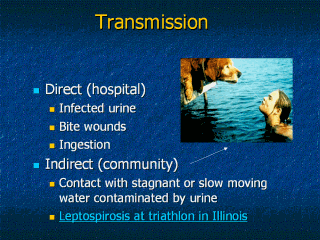| front |1 |2 |3 |4 |5 |6 |7 |8 |9 |10 |11 |12 |13 |14 |15 |16 |17 |18 |19 |20 |21 |22 |23 |24 |25 |26 |27 |28 |29 |30 |31 |32 |33 |review |
 |
· Most leptospirosis
in humans and animals is the result of indirect transmission from swimming
in or drinking water that has been contaminated by animals that shed the
organism in their urine. · In 1998, 110 (9%) of 1194 athletes participating in triathlons in Illinois and Wisconsin developed a febrile illness characterized by chills, headache, myalgia, diarrhea, and eye pain that was later diagnosed by serology as leptospirosis. The specific source of contamination of the lakes in which the athletes swam was not identified. · Veterinarians and veterinary technicians are at risk of acquiring leptospirosis by handling dogs with leptospirosis. A number of cases of leptospirosis in this high risk group have recently been attributed to catheterizing dogs without wearing gloves. Families with dogs that have leptospirosis are also at risk of infection. |